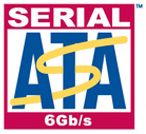SATA Spec 3.0 Now Official; 6 Gb/sec. Speeds
The Serial ATA International Organization has today made official the Serial ATA Revision 3.0 specification.

The Serial ATA International Organization (SATA-IO) today made official the Serial ATA Revision 3.0 specification. The new interface now offers up to six gigabits per second (Gb/sec.) via a high-speed serial data link between storage units, disk drives, optical and tape drives, and more. The new 3.0 spec also offers enhancements to support multimedia applications, enhancements for increased functionality, and is even backwards compatible with earlier SATA implementations 1.5 and 3 Gb/sec.
“As speed becomes critical to today’s storage, the SATA Revision 3.0 specification doubles the maximum transfer speed enabled by technology, paving the way for a new generation of faster SATA products,” said Knut Grimsrud, SATA-IO president and Intel Fellow and director of storage architecture. “SATA-IO members will be able to design for their customers products with the speed they crave, without compromising the quality and performance they’ve come to expect from SATA technology.”
In addition to maintaining low cost and low power consumption via improved power management capabilities, the SATA-IO also provided a few general highlights with today's announcement. A new Native Command Queuing (NCQ) streaming command will be available in 3.0, enabling isochronous data transfers, specifically for audio and video applications that consume large chunks of bandwidth. 3.0 also provide a new connector designed to accommodate 7mm optical disk drives suited for thinner and lighter notebooks. A small, Low Insertion Force (LIF) connector will also be available for more compact 1.8-inch storage devices.
SATA-IO said that network administrators and computer equipment manufacturers will see an immediate benefit after moving from SATA 3 Gb/sec. to SATA 6 Gb/sec., with data transfers now taking half the amount of time; hard drive caching will experience faster transfers of short bursts of data. The SATA 6 Gb/sec. connection also minimizes the throughput bottleneck suffered by today's faster solid state drives; future SSDs will require 6Gb/sec. connectivity. With the reduced latency of SATA 6 Gb/sec., RAID performance will dramatically improve, workstation applications will perform better, and storage area network drives will experience an increase in data streams, boosting storage network density and efficiency.
The SATA-IO also added that the same cables and connectors used for current SATA environments could be used to connect SATA 6 Gb/sec. devices. However, cables already maxed out using the current 3 Gb/sec. operating margins will not perform quite as well using the new SATA 6 Gb/sec. because of an increased number of resends. The SATA-IO basically recommends that end-users utilize "quality components to ensure data integrity and robust operation" at the faster rate. Put simply, buy new cables.
"The SATA interface has developed into the de facto standard HDD interface in computing applications," said John Rydning, research director for hard disk drives at analyst firm IDC. "The new SATA Revision 3.0 specification builds upon the current market success of SATA, and will help to solidify SATA as the predominant storage device interface technology for the foreseeable future."
Stay on the Cutting Edge
Join the experts who read Tom's Hardware for the inside track on enthusiast PC tech news — and have for over 25 years. We'll send breaking news and in-depth reviews of CPUs, GPUs, AI, maker hardware and more straight to your inbox.
-
apache_lives heh you know all these specs have been useless untill the SSD's were released and actually capable of speeds upto and beyond the port speedsReply -
apache_lives and i dont see any point in any desktop hard drive to have this spec either - they barely even reach the ATA100 spec under sustained read/writesReply -
knutjb It's good to see the interface stay ahead of the storage. Since AMD was deeply involved with this development will they get to market before Intel?Reply -
eklipz330 if they manage to boot off of those way faster pcie ssd's, sata will go the way of the dinosaur in no timeReply -
ricardok but.. HDDs can't even reach ATA specs..Reply
Now we will all have to move to SSDs to enjoy that speeds?
SCSI is indeed dead since SATA became popular.
If it wasn't for the low life expectancy of SSDs (when compared to HDDs) than I would jump into the new "format". -
curnel_D There really isnt even a non-PCIe SSD that's capable of current SATA2 specs. With current Sata drives, the fastest read spead I can find is 260 mb/s, which leaves quite a bit of headroom for SATA2's 384 mb/s max.Reply -
curnel_D RicardoKIf it wasn't for the low life expectancy of SSDs (when compared to HDDs) than I would jump into the new "format".And this is the results of being uninformed. Disk based drives in most cases will fail within 5-10 years. Most SSD's are rated to last much longer, as well as the ability to have on the fly data protection. With warranty times the often the same, there's absolutely no reason to hold off on SSD aside from costs/space requirements.Reply -
knutjb eklipz330if they manage to boot off of those way faster pcie ssd's, sata will go the way of the dinosaur in no timeHow big of drive can you get, how many can you fit and how much per GB/TB? For a main drive on a high end machine that might be great, for general storage there aren't enough PCIe slots since they will be competing with graphics, audio, etc...for that limited real estate. I don't see SATA going away for awhile.Reply
Most Popular



